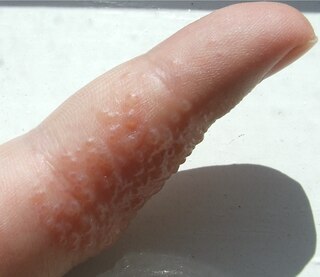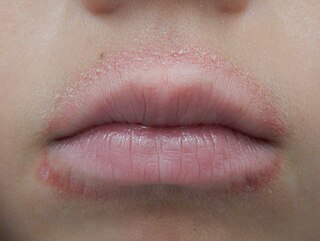Related Research Articles

Propylene glycol (IUPAC name: propane-1,2-diol) is a viscous, colorless liquid, which is nearly odorless but possesses a faintly sweet taste. Its chemical formula is CH3CH(OH)CH2OH. As it contains two alcohol groups, it is classed as a diol. It is miscible with a broad range of solvents, including water, acetone, and chloroform. In general, glycols are non-irritating and have very low volatility.

p-Phenylenediamine (PPD) is an organic compound with the formula C6H4(NH2)2. This derivative of aniline is a white solid, but samples can darken due to air oxidation. It is mainly used as a component of engineering polymers and composites like kevlar. It is also an ingredient in hair dyes and is occasionally used as a substitute for henna.

Contact dermatitis is a type of acute or chronic inflammation of the skin caused by exposure to chemical or physical agents. Symptoms of contact dermatitis can include itchy or dry skin, a red rash, bumps, blisters, or swelling. These rashes are not contagious or life-threatening, but can be very uncomfortable.

Quaternium-15 is a quaternary ammonium salt that has been used as a surfactant and preservative. It acts as an antimicrobial agent because it slowly releases formaldehyde, which is a preservative with biocidal properties.

Dyshidrosis is a type of dermatitis that is characterized by itchy blisters on the palms of the hands and bottoms of the feet. Blisters are generally one to two millimeters in size and heal over three weeks. However, they often recur. Redness is not usually present. Repeated attacks may result in fissures and skin thickening.

Bronopol is an organic compound that is used as an antimicrobial. It is a white solid although commercial samples appear yellow.

A patch test is a diagnostic method used to determine which specific substances cause allergic inflammation of a patient's skin.
Cocamidopropyl betaine (CAPB) is a mixture of closely related organic compounds derived from coconut oil and dimethylaminopropylamine. CAPB is available as a viscous pale yellow solution and it is used as a surfactant in personal care products and animal husbandry. The name reflects that the major part of the molecule, the lauric acid group, is derived from coconut oil. Cocamidopropyl betaine to a significant degree has replaced cocamide DEA.

Allergic contact dermatitis (ACD) is a form of contact dermatitis that is the manifestation of an allergic response caused by contact with a substance; the other type being irritant contact dermatitis (ICD).
Hydroxymethylpentylcyclohexenecarboxaldehyde is a synthetic fragrance known by the trade names Lyral, Kovanol, Mugonal, Landolal. It is found in some soaps, eau de toilettes, aftershaves and deodorants.

Diazolidinyl urea is an antimicrobial preservative used in cosmetics. It is chemically related to imidazolidinyl urea which is used in the same way. Diazolidinyl urea acts as a formaldehyde releaser.

Thiuram disulfides are a class of organosulfur compounds with the formula (R2NCSS)2. Many examples are known, but popular ones include R = Me and R = Et. They are disulfides obtained by oxidation of the dithiocarbamates. These compounds are used in sulfur vulcanization of rubber as well as in the manufacture of pesticides and drugs. They are typically white or pale yellow solids that are soluble in organic solvents.

A formaldehyde releaser, formaldehyde donor or formaldehyde-releasing preservative is a chemical compound that slowly releases formaldehyde. Formaldehyde-releasers are added to prevent microbial growth and extend shelf life. The intent of these compounds is that they release formaldehyde at levels that suppress microbial growth but sufficiently low to not threaten humans. The use of these chemicals in cosmetics has elicited controversy.
Eyelid dermatitis is commonly related to atopic dermatitis or allergic contact dermatitis. Volatile substances, tosylamide, epoxy hardeners, insect sprays, and lemon peel oil may be implicated, with many cases of eyelid contact dermatitis being caused by substances transferred by the hands to the eyelids.

Tixocortol pivalate is a corticosteroid. It has anti-inflammatory properties similar to hydrocortisone. It is marketed under the brand name Pivalone.

Iodopropynyl Butyl Carbamate (IPBC) is a water-soluble preservative used globally in the paints & coatings, wood preservatives, personal care, and cosmetics industries. IPBC is a member of the carbamate family of biocides. IPBC was invented in the 1970s and has a long history of effective use as an antifungal technology.

Methyldibromo glutaronitrile (MDBGN) is a widely used preservative.

Nickel allergy is any of several allergic conditions provoked by exposure to the chemical element nickel. Nickel allergy often takes the form of nickel allergic contact dermatitis (Ni-ACD), a form of allergic contact dermatitis (ACD). Ni-ACD typically causes a rash that is red and itchy and that may be bumpy or scaly. The main treatment for it is avoiding contact with nickel-releasing metals, such as inexpensive jewelry. Another form of nickel allergy is a systemic form: systemic nickel allergy syndrome (SNAS) can mimic some of the symptoms of irritable bowel syndrome (IBS) and also has a dermatologic component.

Para tertiary butylphenol formaldehyde resin also known as p-tert-butylphenol-formaldehyde resin (PTBP-FR) or 4-(1,1-dimethylethyl) phenol is a phenol-formaldehyde resin found in commercial adhesives, and in particular in adhesives used to bond leather and rubber. It has broad usage in a large variety of industries and can be found in many household items and textile products, and in particular it is used in the manufacture of shoes.

Lip licker's dermatitis is a type of skin inflammation around the lips due to damage by saliva from repetitive lip licking and is classified as a subtype of irritant contact cheilitis. The resulting scaling, redness, chapping, and crusting makes a well-defined ring around the lips. The rash may extend as far as the tongue can reach and usually does not occur at the corners of the mouth. It commonly occurs during winter months but some people can have it year-round if lip licking is a chronic habit.
References
- ↑ "Review ACDS' Allergen of the Year 2000-2015". www.hmpgloballearningnetwork.com. Retrieved 2024-01-24.
- ↑ Johnson, Hadley; Norman, Thomas; Adler, Brandon L.; Yu, JiaDe (August 2023). "Lanolin: The 2023 American Contact Dermatitis Society Allergen of the Year". Cutis. 112 (2): 78–81. doi:10.12788/cutis.0825. ISSN 2326-6929. PMID 37820332.
- ↑ Novack, Danielle E.; Yu, Jiade; Adler, Brandon L. (July 2022). "Aluminum: The 2022 American Contact Dermatitis Society Allergen of the Year". Cutis. 110 (1): 21–24. doi:10.12788/cutis.0566. ISSN 2326-6929. PMID 36179228.
- ↑ Reeder, Margo; Atwater, Amber Reck (May 2021). "Acetophenone Azine: The 2021 American Contact Dermatitis Society Allergen of the Year". Cutis. 107 (5): 238–240. doi:10.12788/cutis.0252. ISSN 2326-6929. PMID 34288849.
- ↑ Jan 01;325-9, Dermatitis Acetophenone Azine Dermatitis 2021; Raison-Peyron, N.; MEDLINE®/PubMed®, D. Sasseville From; Medicine, a database of the U. S. National Library of. "Acetophenone Azine". PracticeUpdate. Retrieved 2024-01-26.
{{cite web}}: CS1 maint: multiple names: authors list (link) CS1 maint: numeric names: authors list (link) - ↑ Aerts O, Herman A, Mowitz M, Bruze M, Goossens A (6 Jan 2020), "Isobornyl Acrylate.[Contact Allergen of the Year].", Dermatitis, 31 (1): 4–12, doi:10.1097/DER.0000000000000549, PMID 31913984, S2CID 210119397
- ↑ Militello, Michelle; Hu, Sophia; Laughter, Melissa; Dunnick, Cory A.; Sasseville, D.; Fowler Jr, J. F.; Dekoven, J. G.; Pratt, M. D.; Maibach, H. I.; Taylor, J. S.; Marks, J. G.; Mathias CGT; Deleo, V. A.; Zirwas, J. M.; Zug, K. A.; Atwater, A. R.; Silverberg, J.; Reeder, M. J. (2020). "American Contact Dermatitis Society Allergens of the Year 2000 to 2020". Dermatologic Clinics. 38 (3): 309–320. doi:10.1016/j.det.2020.02.011. PMID 30570578. S2CID 219050576.
- ↑ Fransway, Anthony F.; Fransway, Paulina J.; Belsito, Donald V.; Yiannias, James A. (January 2019). "Paraben Toxicology". Dermatitis. 30 (1): 32–45. doi:10.1097/DER.0000000000000428. ISSN 2162-5220. PMID 30570577. S2CID 58580094.
- ↑ Fransway, AF; Fransway, PJ; Belsito, DV (2019). "Parabens". Dermatitis. 30 (1): 3–31. doi:10.1097/DER.0000000000000429. PMID 30570578. S2CID 58552762.
- ↑ Jacob, Sharon E; Scheman, Andrew; McGowan, Maria A (2018). "Propylene Glycol". Dermatitis. 29 (1): 3–5. doi:10.1097/DER.0000000000000315. PMID 29059092. S2CID 24598433.
- ↑ "What is the 2017 Allergen of the Year? | the Dermatologist".
- ↑ Fowler, Joseph F. (2016). "Cobalt". Dermatitis: Contact, Atopic, Occupational, Drug. 27 (1): 3–8. doi:10.1097/DER.0000000000000154. ISSN 2162-5220. PMID 26756508.
- ↑ Pontén, Ann; Bruze, Magnus (2015). "Formaldehyde". Dermatitis. 26 (1): 3–6. doi:10.1097/DER.0000000000000075. PMID 25581665.
- ↑ Heurung, Ashley R.; Raju, Srihari I.; Warshaw, Erin M. (2014). "Benzophenones". Dermatitis. 25 (1): 3–10. doi:10.1097/DER.0000000000000025. PMID 24407064.
- ↑ "Benzophenones named 2014 Contact Allergen of the Year". www.mdedge.com. Retrieved 2024-01-24.
- ↑ Castanedo-Tardana, Mari Paz; Zug, Kathryn A. (2013). "Methylisothiazolinone". Dermatitis. 24 (1): 2–6. doi:10.1097/DER.0b013e31827edc73. PMID 23340392. S2CID 220573338.
- ↑ Wachter, Kerri (16 March 2012). "Acrylates Named Contact Allergen of the Year". Archived from the original on 21 April 2015.Dermatology News.
- ↑ Sasseville, D (2012). "Acrylates in contact dermatitis". Dermatitis. 23 (1): 6–16. doi:10.1097/DER.0b013e31823d1b81. PMID 22653063. S2CID 5498021.
- ↑ McNamara, Damian (3 February 2011). "Dimethyl Fumarate Named 2011 Allergen of the Year". Family Practice News.
- ↑ Bruze, M; Zimerson, E (2011). "Dimethyl fumarate". Dermatitis. 22 (1): 3–7. doi:10.2310/6620.2011.00002. PMID 21291637. S2CID 220574758.
- ↑ McNamara, Damian. (2010). Neomycin Is Named Contact Allergen of the Year Archived 2015-04-22 at archive.today
- ↑ Sasseville, D (2010). "Neomycin". Dermatitis. 21 (1): 3–7. doi:10.2310/6620.2009.09073. PMID 20137735. S2CID 220581833.
- ↑ "American Contact Dermatitis Society names mixed dialkyl thioureas contact allergen of the year" (PDF). American Contact Dermatitis Society. 20 March 2009. Archived from the original (PDF) on 3 March 2016. Retrieved 15 May 2019.
- ↑ Anderson, B. E. (2009). "Mixed dialkyl thioureas". Dermatitis. 20 (1): 3–5. doi:10.2310/6620.2008.08062. PMID 19321113.
- ↑ Brunk, Doug. (2008). Nickel is Named Contact Allergen of the Year. Archived 2015-04-27 at the Wayback Machine
- ↑ Kornik, R; Zug, K. A. (2008). "Nickel". Dermatitis. 19 (1): 3–8. doi:10.2310/6620.2008.07082. PMID 18346389.
- ↑ Storrs, Frances J. (2007). "Allergen of the Year: Fragrance". Dermatitis. 18 (1): 3–7. doi:10.2310/6620.2007.06053. PMID 17303039.
- ↑ DeLeo, Vincent A. (2006). "Contact Allergen of the Year: p-Phenylenediamine". Dermatitis. 17 (2): 53–55. PMID 16956454.
- ↑ Macneil, Jane Saladof (2006). "Henna Tattoo Ingredient is Allergen of the Year" (PDF). Skin and Allergy News. Archived from the original (PDF) on 2015-04-27. Retrieved 2015-04-20.
- ↑ Isaksson, Marléne; Bruze, Magnus (2005). "Corticosteroids". Dermatitis. 16 (1): 3–5. PMID 15996344.
- ↑ "Focus on the Non-T.R.U.E. Test Allergen — Cocamidopropyl Betaine". www.hmpgloballearningnetwork.com. Retrieved 2024-01-24.
- ↑ Jacob, S. E.; Amini, S (2008). "Cocamidopropyl betaine". Dermatitis. 19 (3): 157–60. doi:10.2310/6620.2008.06043. PMID 18627690.
- ↑ "Focus On: Bacitracin Allergen of the Year 2003". www.hmpgloballearningnetwork.com. Retrieved 2024-01-24.
- ↑ Sood, A; Taylor, J. S. (2003). "Bacitracin: Allergen of the year". American Journal of Contact Dermatitis. 14 (1): 3–4. PMID 14744414.
- ↑ Ingber, Arieh (2003). "Thimerosal—the surprising allergen of the year". Clinics in Dermatology. 21 (4): 340–1. doi:10.1016/S0738-081X(03)00016-6.
- ↑ "Thimerosal and Vaccines | Vaccine Safety | CDC". www.cdc.gov. 2020-08-25. Retrieved 2024-01-30.
- ↑ Ehrlich, A; Belsito, D. V. (2000). "Allergic contact dermatitis to gold". Cutis. 65 (5): 323–6. PMID 10826096.
- ↑ Chen, Jennifer K.; Lampel, Heather P. (2015). "Gold contact allergy: clues and controversies". Dermatitis: Contact, Atopic, Occupational, Drug. 26 (2): 69–77. doi:10.1097/DER.0000000000000101. ISSN 2162-5220. PMID 25757078.
- ↑ Pratt, M; Taraska, V (2000). "Disperse blue dyes 106 and 124 are common causes of textile dermatitis and should serve as screening allergens for this condition". American Journal of Contact Dermatitis. 11 (1): 30–41. doi:10.1016/S1046-199X(00)90030-7. PMID 10684387.
- ↑ "Disperse Blue Mix 124/106 | Allergic Contact Dermatitis Database". www.contactdermatitisinstitute.com. Retrieved 2024-01-30.